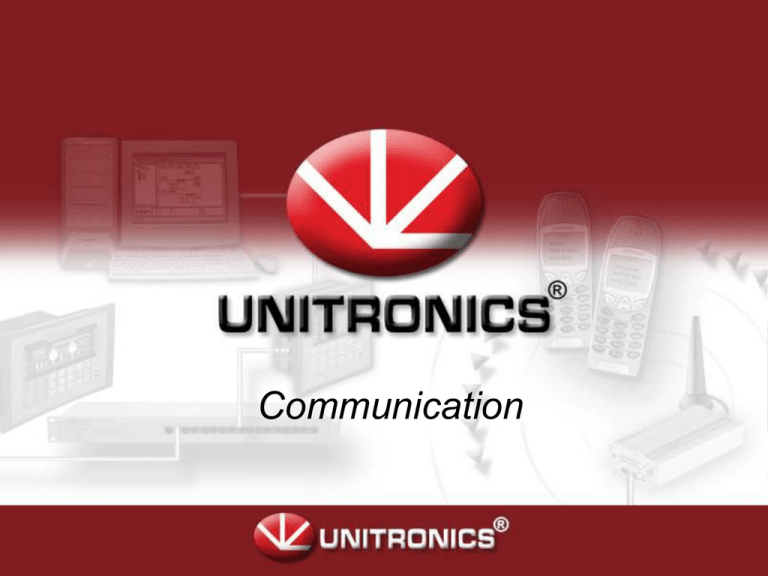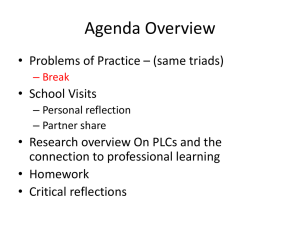Remote Communication
advertisement

Communication COMMUNICATION Between people Voice Language COMMUNICATION Between machines Physical Layer Communication Protocols General Review Physical layer Unitronics PLCs support several physical layers: RS232 (2 units; up to 16 meters) RS485 (up to 32 units; up to 1200 meters – “daisy chain”) CANbus (up to 64 units; up to 1000 meters – “daisy chain”) Ethernet (up to 100 meters from device to HUB – “Star”) General Review Protocols Unitronics PLCs support several Protocols: Pcom (Unitronics private protocol) MODBUS CANbus (Unitronics ISC, UniCAN, CANOpen) MODBUS IP Option to implement third party protocols (RS232/485 and Ethernet) Hardware Review Serial M90 M91/91-2 Jazz (option) V120 1 port, RS232 1 port, RS232/485 2 ports, RS232/485 2 ports, RS232 1 optional port, RS232/485 Some models Some models All models None None Ethernet card (optional) CANbus Some models Ethernet None V230/260/280/290 V570 2 isolated ports, RS232/485 Yes Ethernet card (optional) Protocol Review M90 M91/91-2 V120 V230/260/280/290 /V570 RS232 RS485 Pcom Pcom Pcom Pcom MODBUS MODBUS MODBUS User defined User defined User defined CANbus ISC ISC ISC UniCAN CANOpen ISC UniCAN CANOpen Ethernet None None None Pcom over IP MODBUS IP User defined Physical Layers RS232 Communication parameters • Baud rate: 300 ~ 115200 bps • Start bit: always 1bit • Data bits: 7 or 8 data bits • Parity check: Even, Odd, None – 1 bit • Stop bits: 1, 1.5 or 2 bits Communication “word” can be only 10 or 11 bits All communication parameters in both sides must be exactly the same! M90/91 & Jazz default parameters: 9600, 7, Even, 1 Vision default parameters: 57600/115200, 8, None, 1 Physical Layers RS485 • Communication in “daisy chain” network – up to 32 devices • Balanced half duplex signal (RS485) •Two wires A (Rx/Tx+) and B (Rx/Tx-); • Up to 1200 meters - twisted shielded pair cable; • Supported by Jazz (optional) M91-2-xx, V120, V2xx (optional) controllers, V570 Physical Layers RS485 • Communication parameters – same as in RS232 • Addressing (Unitronics OPLC) – ID 65 ~ 254 Protocol Review The Pcom Protocol All Unitronics PLC operating systems are embedded with the Pcom protocol. Pcom enables Unitronics PLCs as slave devices, enabling them to be accessed by incoming communications via all ports. The Pcom protocol is also the protocol that we use for programming, remote access, and data acquisition The Pcom protocol is addressable by nature (part of the protocol) and so it can work over a network as well. The Pcom protocol is given free as a DLL with all documentation and help for people to implement inside their software. Protocol review The Pcom protocol Two other implementations of the Pcom protocol are the DDEserver and the OPCserver. DDEserver and OPCserver are PC based applications that can, on one hand, take information from our PLCs and on the other give out this information in a format that other Windows based applications can understand (like SCADA systems for example). Our DDE and OPC server are given free on the installation CD of both U90Ladder and VisiLogic, or can be downloaded from our website. Protocol Review The MODBUS protocol One of the most common protocols in the market is the MODBUS protocol. The MODBUS protocol, originally made for Modicon PLCs, is shared by many SCADA applications, drives and other equipment. In order to support MODBUS, the PLC has to conform with the MODBUS addressing structure. MODBUS is a master-slave protocol, and can run over RS232/485 as well as Ethernet. There are different versions of Modbus. We support Modbus RTU (binary) over RS232/485 and Modbus IP over Ethernet What do you think? Let’s make a small application that implements MODBUS communication between two PLCs. One PLC will act as master PLC, and the second will act as slave. Physical Layers CANbus Unitronics’ CANbus runs on the same physical layer as A.B.’s DeviceNet, but uses a different protocols. A CANbus network can include up to 63 PLCs and mix different models of M90/91as well as Vision. CAN bus wiring Specifications CAN bus Cable Lookout Protocol Review CANbus as Bridge A PC can ‘talk’ to a Vision via the RS232 serial port. The PLC can act as a ‘bridge’ between RS232 and CANbus. Up to 63 PLCs can be connected in a CANbus net and then linked via the ‘bridge’ to a PC. The PC can ‘see’ each PLC in the CANbus net. The ‘bridge controller’ needs no special programming or hardware. Any random controller in the net can act as the bridge. This connection also allows software download and upload to every PLC on the net. In the case of a mixed network (M90/91 and Visions) the bridge controller must be a Vision PLC. CAN bus Network to PC Unit ID 1 Bridge Unit ID 2 Unit ID 3 Protocol Review Protocols over CANbus PLCs on the CANbus network can also ‘talk’ among themselves. In Unitronics protocols – ISC and UniCAN, the PLCs are both master and slave. ISC and UniCAN are Multimaster protocols CANOpen is protocol, supported by a lot of third party devices. It’s supported only by Vision series OPLC. Unitronics acts as Master. One Unitronics controller can be connected to few other devices. What do you think? Let’s build a small application that connects two PLCs in CANbus - UniCAN and allows them to read information from each other. Remote Communication Modem All Unitronics PLCs support modem connection. Connecting to the PLC from afar enables one to remotely download, debug and upload applications. Remote Communication Modem Unitronics PLCs support 4 types of modems: PSTN modem (Plain Simple Telephone Network) GSM/GPRS modem (wireless) CDMA modem RF modems Remote Communication Modem When we want to connect a PC to a PLC via modem we have 3 aspects to look at: PLC to modem Modem to modem Modem to PC The cable connecting the PLC and modem is the Unitronics’ programming cable, accompanied by a special connector (each modem has its own). The modem has to be prepared, via software, before it is connected. The connection can be established both from the PC and the PLC Remote communication SMS One of the major advantages of cellular modems is the ability to send short text messages (SMS). SMS is a global standard that allows the sending of characters from one phone to the another. The phones can either be on the same network or on different ones (depending on agreements between the cellular providers). Remote Communication SMS The ability to connect the PLC to a cellular phone opens up a wide variety of applications. Basically, a PLC connected to a GSM modem can receive pre-programmed messages and act accordingly. The PLC can also respond by sending a message to a cellular phone. Remote Communication Another important part of Remote Access is the Ethernet Remote Communication Ethernet Unitronics’ Vision230/260/280/290/570 all support Ethernet. Our Ethernet Card offers 4 sockets and works with both TCP/IP and UDP/IP. The Ethernet card can work with speeds of either 10 or 100Mbps. The PLC supports the MODBUS over TCP protocol and uses this as the connection to SCADA systems and among PLCs. Remote Communication Software Utilities As part of Unitronics philosophy, we provide a special software utilities free with our Software CDs. This utility enables PC to PLC modem connection and remote access—even without VisiLogic or U90Ladder software. Remote Communication Remote access This easy to use tool is in fact a very simple “SCADA” It enables monitoring and operate of the controller from PC. Remote access supports RS232/485, Modems, Ethernet and CAN bus via “bridge”. Remote Communication DataXport This tool is especially designed to make automated reading of Data Tables from Remote OPLC to PC. Supports RS232/485, modem connection and Ethernet. Unitronics – Thank You RS485 Wiring Specifications CAN bus Cable Lookout RS232/RS485 Port Pinout M91-19-4xx, the new M91-2-xx and Vision series controllers have common RS232/485 COM ports. RS232 or RS485 are jumper selectable. General Review In order to establish communication we need to deal with 4 elements: Physical layer Protocol Baud rate Data structure What do you think? What's the maximum number of PCs that can ‘look’ simultaneously at one PLC? Let’s make a small application that communicates between two PLCs over the Ethernet. General Review Baud rate Unitronics PLCs support a wide range of baud rates: 9600-57600bps for serial communication 50-1000Kbps For CANbus 10/100Mbps for Ethernet General Review Data structure Unitronics PLCs support different structures: 10/11 for serial 11 bit format TCP or UPD for Ethernet Physical Layers RS232 • Communication between two devices only • Unbalanced full duplex signal • Up to 16 meters • Supported by all Unitronics controllers Physical Layers RS232 Two types of communicating devices: DTE (Data Terminal Equipment) •Computers •Controllers DCE (Data Circuit-Terminated Equipment) •Printers •Modems Male DB9 Female DB9 Physical Layers RS232 DTE signals and pin-out Computer Unitronics OPLC DCE signals and pin-out What do you think? Can I centralize information from 9 PLCs on the CANbus network into one PLC? What is the maximum number of PCs that can simultaneously look at the data within a Unitronics CANbus network? I have a sensor that runs on CANopen. Can I connect it to the CANbus network and read the value inside the PLC? Remote Communication Modem A modem, in general, has two modes of operation: Data mode Command mode In Data mode, the modem is a tube conveying data between two points. When we talk of modems in a use the AT In Command mode, one can network (liketoRF), we must ascertain commands communicate with the that the modem not add modem, changedoes settings, or make the anything to the data; if it does, we modem perform different operations. must take it into consideration the The modem stays in commandinmode protocol. In order to entertodata until someone connects it, ormode, gives the has to connect to the themodem dial command. other modem (or the network), and at the end of the session it must disconnect. What do you think? What conditions have to be met in order to download an operating system over a modem? Can I use internal modems on the PC? What selections do I have to make in the PC modem configuration? Can I be connected, over modem, to more than one PLC at a time? What do you think? I want to have a system that will call me every time there is an event, can I do that? What will happen when the system calls? If I want to connect to one of my PLCs for debugging, can SMS messages still flow in and out of the modem? Can an SMS be considered as a real-time event from the system?






